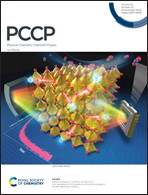Low-temperature NO oxidation using lattice oxygen in Fe-site substituted SrFeO3−δ†
Abstract
Improvement of the low-temperature activity for NO oxidation catalysts is a crucial issue to improve the NOx storage performance in automotive catalysts. We have recently reported that the lattice oxygen species in SrFeO3−δ (SFO) are reactive in the oxidation of NO to NO2 at low temperatures. The oxidation of NO using lattice oxygen species is a powerful means to oxidize NO in such kinetically restricted temperature regions. This paper shows that Fe-site substitution of SFO with Mn or Co improves the properties of lattice oxygen such as the temperature and amount of oxygen release/storage, resulting in the enhancement of the activity for NO oxidation in a low-temperature range. In particular, NO oxidation on SrFe0.8Mn0.2O3−δ is found to proceed even at extremely low temperatures <423 K. From oxygen release/storage profiles obtained by temperature-programmed reactions, Co doping into SFO increases the amount of released oxygen owing to the reducibility of the Co species and promotes the phase transformation to the brownmillerite phase. On the other hand, Mn doping does not increase the oxygen release amount and suppresses the phase transformation. However, it significantly decreases the oxygen migration barrier of SFO. Substitution with Mn renders the structure of SFO more robust and maintains the perovskite structure after the release of oxygen. Thus, the oxygen release properties are strongly dependent on the crystal structure change before and after oxygen release from the perovskite structure, which has a significant effect on NO oxidation and the NOx storage performance.

- This article is part of the themed collection: 2020 PCCP HOT Articles


 Please wait while we load your content...
Please wait while we load your content...